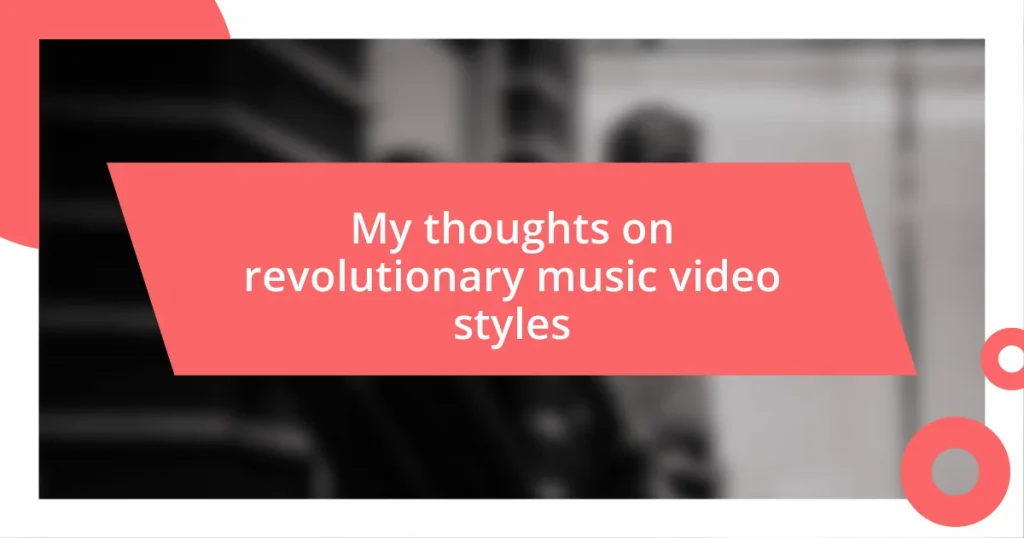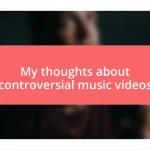Key takeaways:
- The evolution of music videos has transformed them from simple promotional tools to complex forms of artistic expression, incorporating storytelling and cultural representation.
- Revolutionary music videos utilize innovative visuals, emotional impact, and cultural representation to provoke thought and engage viewers deeply.
- Cinematic techniques, such as lighting, dynamic camera movements, and editing, enhance storytelling, creating a profound connection between the audience and the music.

Understanding music video evolution
Music videos have come a long way since their inception in the 1980s. I remember watching early MTV, where flashy visuals and simple narratives ruled the screen. It’s fascinating to think about how much has changed since then—how do we get from “Thriller” to the immersive, almost cinematic experiences we see today?
As the years went by, the music video transformed into a form of artistic expression, blending storytelling, dance, and even social commentary. I vividly recall a moment when I first watched Björk’s “All Is Full of Love”; that innovative use of robotics and intense emotions left a lasting impression on me. Have you ever felt emotionally stirred by a video in a way that stayed with you long after it ended?
Now, with the rise of digital platforms, music videos have become more than just promotional tools; they’re a vital part of an artist’s identity. It excites me to see how artists leverage various styles—from animation to virtual reality—to push boundaries. Which style resonates most with you? In today’s fast-paced world, the evolution of music videos is a reflection of changing technology and artistic vision, constantly inviting viewers to engage in new ways.

Key elements of revolutionary styles
Music videos harness elements that set them apart as revolutionary, such as innovative visuals, storytelling depth, and technological integration. I recall the first time I watched OK Go’s “Here It Goes Again” — their use of creative choreographed treadmill routines was not just entertaining; it redefined what a music video could achieve through playful, yet meticulous execution. This blend of choreography and engineering made me appreciate the artistic challenges involved in each shot.
Another key element is the ability to evoke emotions and provoke thought. Take, for instance, Childish Gambino’s “This Is America.” The juxtaposition of vibrant visuals with dark themes was striking and haunting. Watching it left me grappling with the heavy social commentary while simultaneously feeling the beat envelop me. It sparked conversations among friends and left us questioning our own perspectives, making it more than just a video.
Finally, a revolutionary music video often embraces cultural elements and embraces diversity in representation. I remember feeling a sense of pride and connection when I watched BTS’s “Butter.” Their ability to blend styles, not only musically but visually, showcased a celebration of their heritage while breaking language barriers. This level of representation resonates deeply with me, as it highlights how art can unite us despite our differences.
| Element | Description |
|---|---|
| Innovative Visuals | Use of creative techniques to enhance storytelling and engage the viewer. |
| Emotional Impact | Ability to provoke thought and evoke feelings through powerful themes and imagery. |
| Cultural Representation | Inclusion of diverse elements that reflect varying cultures and experiences. |

Cinematic techniques in music videos
When it comes to cinematic techniques in music videos, I’ve noticed how they can completely transform the viewer’s experience. A well-executed video makes you feel as though you’re part of an unfolding story. For example, I still get chills watching Sia’s “Chandelier,” where the fluidity of movement and striking visuals create a powerful narrative that resonates with themes of struggle and triumph. The way they used lighting and camera angles adds depth, drawing me into the emotional core of the song.
- Cinematic Lighting: The use of light to create moods and emphasize emotions, such as the dramatic use of shadows in “Chandelier.”
- Dynamic Camera Movements: Engaging movement techniques, like tracking shots, give a sense of immersion, as seen in Billie Eilish’s “When the Party’s Over.”
- Editing Techniques: Quick cuts and transitions can heighten emotional impact or create tension, such as the erratic edits in Eminem’s “Stan.”
I find it fascinating how editing and pacing influence the storytelling within a music video. For instance, consider how the slow-motion sequences in Coldplay’s “Up&Up” allow each visual element to sink in, amplifying the overall emotional experience. It’s like watching a painting come alive, where every detail matters. As I reflect on these techniques, I realize how they not only enhance storytelling but also create a lasting connection with the audience, helping each video stand out like a distinct piece of art.

Analyzing iconic music video examples
Taking a closer look at iconic music videos can reveal much about their narrative and artistic choices. One that often stands out for me is Beyoncé’s “Formation.” Her use of powerful imagery, from the opening shots of New Orleans to the striking visuals celebrating Black culture, left an indelible mark on my understanding of representation in media. It felt like a bold statement that challenged viewers to reflect on social justice and identity, encouraging conversations that went beyond just the music itself.
Another example is the surreal world of Radiohead’s “Pyramid Song.” The ethereal vibe, combined with haunting visuals and abstract storytelling, transported me to another realm. I found myself questioning reality and existence as I watched, which is not something I expected from a music video. It was a perfect blend of sound and vision, stirring complex emotions that lingered long after the video ended. Have you ever watched something that resonated so deeply it made you rethink your perspectives? That’s the power this kind of artistic expression holds.
Then there’s Taylor Swift’s “The Man,” where she cleverly flips traditional gender norms on their head. The storytelling here isn’t just clever; it’s eye-opening. As I watched her embody different characters, I felt a pang of recognition regarding societal expectations. It’s more than just entertainment; it’s a call to action, urging us to analyze the roles we play. Each of these examples illustrates how revolutionary music videos go beyond visuals to provoke thought and create emotional experiences that can resonate with viewers on a personal level.















